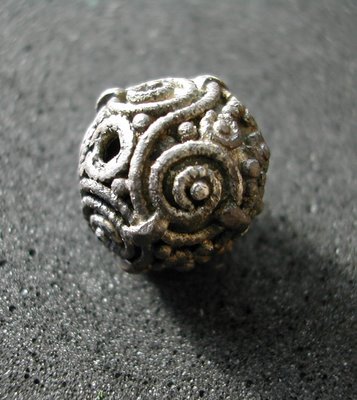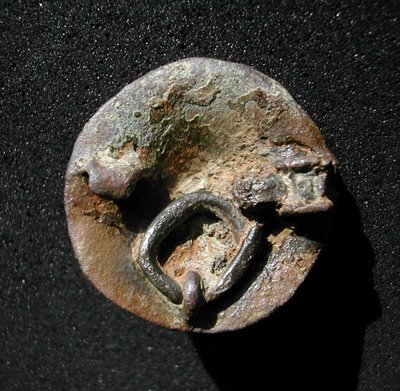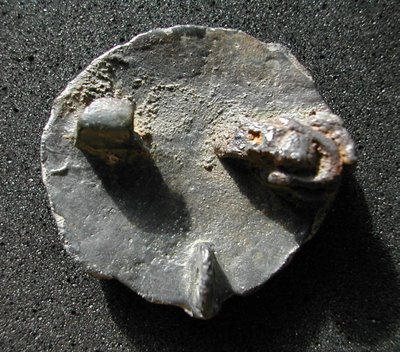Viking Period Jewellery
The finds from my Easter fieldwork with Tim and Kenth and the others in Östergötland are back from conservation in Kiruna, where Bosse Johansson-Närvä Engström has given them some loving care and attention. Below are pix of some of the prettiest pieces, previously seen only by a handful of people since they were buried back in the day. They're from three ploughed-over 10th century pagan inhumation cemeteries of which only one was known before we started working.


Above are front and back views of a large disc brooch from Hagebyhöga parish (previously shown here in its pre-conservation state). It's early 10th century, executed in the Borre style and cast in copper alloy. The remains of the iron pin are still on its back side, showing that the pin has rusted in a locked position as when the brooch was fastened to a lady's dress. On the back side are also remains of a cast loop near the edge to fasten a bead string or a fine chain to hold small utensils. Identical brooches are known from the proto-town of Birka in the Lake Mälaren area, where this piece may very well have been made. Ingmar Jansson calls the type II A4.

This little beauty is only about a centimeter in diameter. It's a silver filigree bead from the same site as the large disc brooch. Imagine making all those little ornaments of beaded wire and soldering them in place along with granules of silver! That's the beauty of precious metal: the skill of the prehistoric artisans can be appreciated undiminished by any corrosion.


Here's another Borre style disc brooch, a small one, with mercury gilding. It's from Östra Husby parish. Jansson calls the type IIA, and this too is known from Birka. Look at the three little Mickey Mouse heads! This brooch has the same fastening arrangements as the large one, and in this case a copper alloy wire ring is still on the lower fastening loop.


This little disc brooch of Jansson's type IB is from Västra Tollstad parish. It's later than the others, decorated in the late-10th century Jelling style, but wear has obscured the interlace. You'll have to trust me: the spaghetti is actually a dragon with a hatched body. The pin is better preserved on this brooch: the spring is visible and there's a wire ring around the pin's fastening lugs.
Dear Reader, isn't finds porn great?
Jansson, I. 1984. Grosse/kleine Rundspangen. Arwidsson, G. (ed.). Birka II:1. Systematische Analysen der Gräberfunde. KVHAA. Stockholm.
[More blog entries about vikings, vikingperiod, jewellery, archaeology, Sweden; vikingatiden, smycken, arkeologi, Östergötland.]


Above are front and back views of a large disc brooch from Hagebyhöga parish (previously shown here in its pre-conservation state). It's early 10th century, executed in the Borre style and cast in copper alloy. The remains of the iron pin are still on its back side, showing that the pin has rusted in a locked position as when the brooch was fastened to a lady's dress. On the back side are also remains of a cast loop near the edge to fasten a bead string or a fine chain to hold small utensils. Identical brooches are known from the proto-town of Birka in the Lake Mälaren area, where this piece may very well have been made. Ingmar Jansson calls the type II A4.

This little beauty is only about a centimeter in diameter. It's a silver filigree bead from the same site as the large disc brooch. Imagine making all those little ornaments of beaded wire and soldering them in place along with granules of silver! That's the beauty of precious metal: the skill of the prehistoric artisans can be appreciated undiminished by any corrosion.


Here's another Borre style disc brooch, a small one, with mercury gilding. It's from Östra Husby parish. Jansson calls the type IIA, and this too is known from Birka. Look at the three little Mickey Mouse heads! This brooch has the same fastening arrangements as the large one, and in this case a copper alloy wire ring is still on the lower fastening loop.


This little disc brooch of Jansson's type IB is from Västra Tollstad parish. It's later than the others, decorated in the late-10th century Jelling style, but wear has obscured the interlace. You'll have to trust me: the spaghetti is actually a dragon with a hatched body. The pin is better preserved on this brooch: the spring is visible and there's a wire ring around the pin's fastening lugs.
Dear Reader, isn't finds porn great?
Jansson, I. 1984. Grosse/kleine Rundspangen. Arwidsson, G. (ed.). Birka II:1. Systematische Analysen der Gräberfunde. KVHAA. Stockholm.
[More blog entries about vikings, vikingperiod, jewellery, archaeology, Sweden; vikingatiden, smycken, arkeologi, Östergötland.]



8 Comments:
"Finds porn"? Did I miss something????
The brooches and the bead are really well preserved! The amazing craftsmanship we find in artifacts like these never ceases to amaze me. It's amazing what people could do without our "modern" technology. What's even more amazing? Even with all our "advancements" we can't replicate anything that even comes close to how beautiful those brooches (and the bead) are.
I just noticed that I used the words "amazing" and "amaze" four times in two senctences...I should proofread before hitting the submit button.
You didn't miss anything. The reason that you said amaz* four times in one breath was simply that my finds porn had made you all hot 'n' buttered.
Yep, that's me. I know what really gets the ladies going.
With such findings I can understand why some people like to be archeologists!
Nice tree-blog of yours from 1st of June - thanks to your key-word "träd" I came here!
my blogg
Http://giraffen197.webblogg.se
Unfortunately, very few archaeologists these days get to find stuff like that. It's because sites are selected for excavation on the grounds that well-preserved sites with a lot of finds are avoided. Land developers don't want to pay more than necessary for excavation and conservation.
"hot and buttered"? Your wife is a lucky lady!
Post a Comment
<< Home